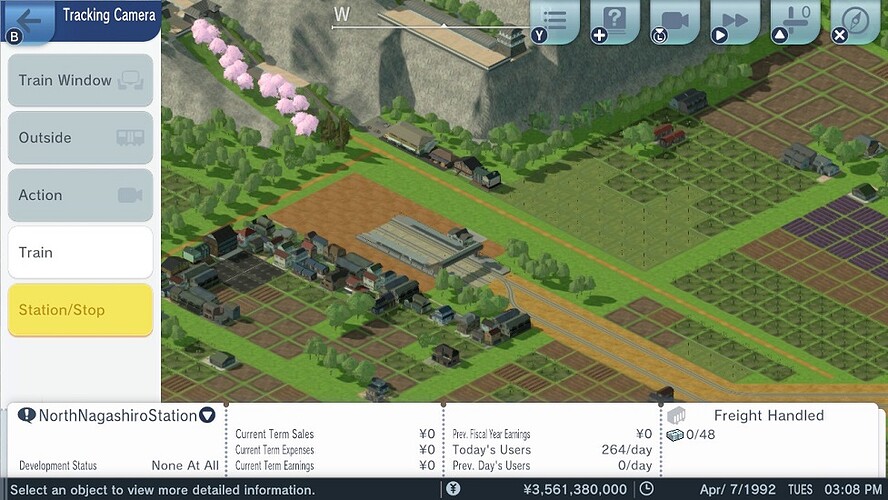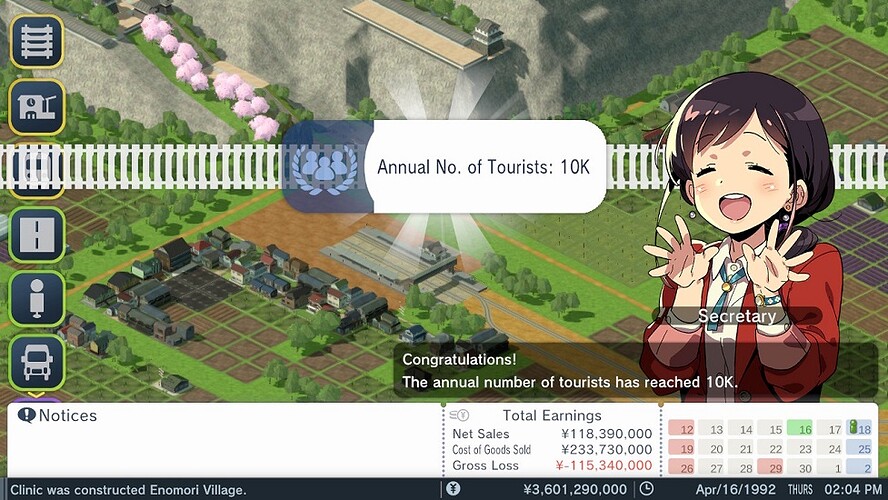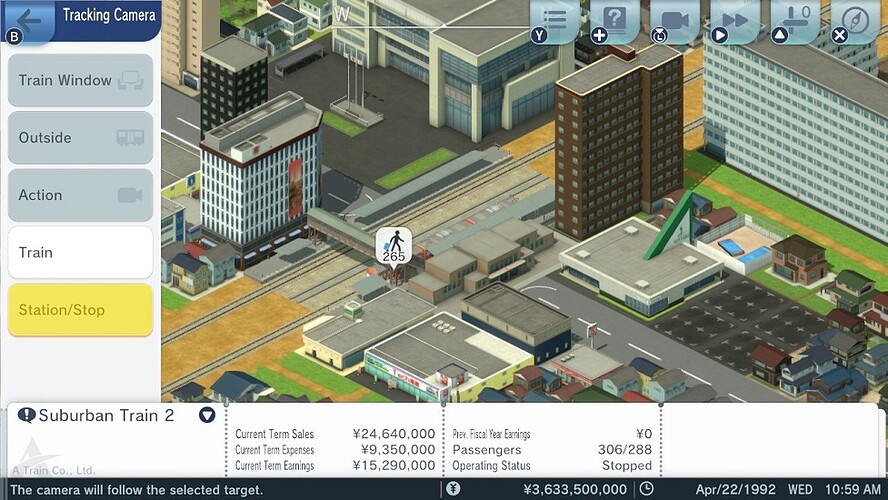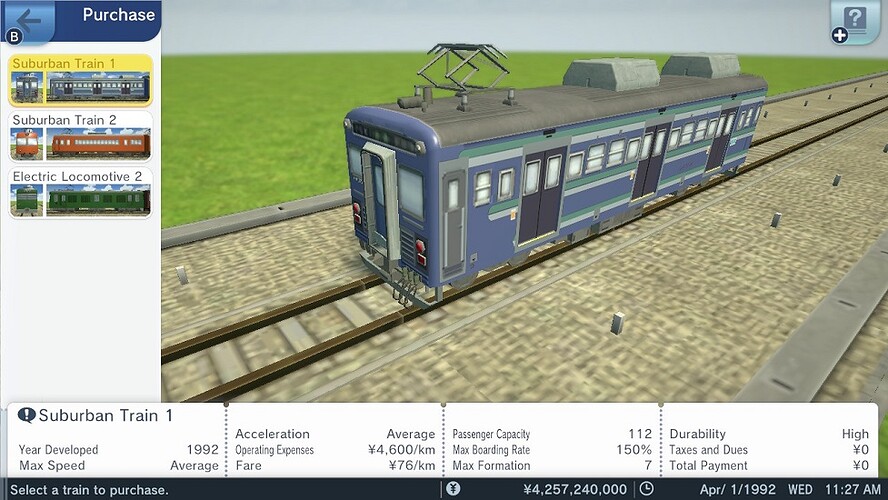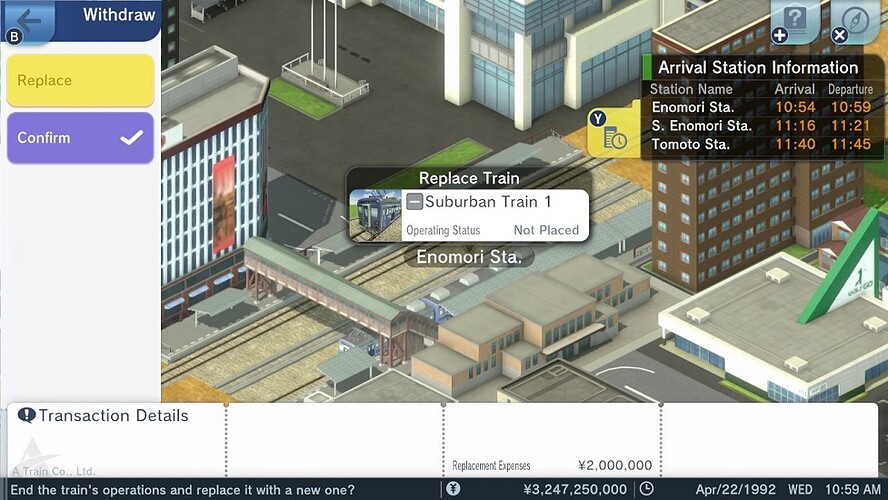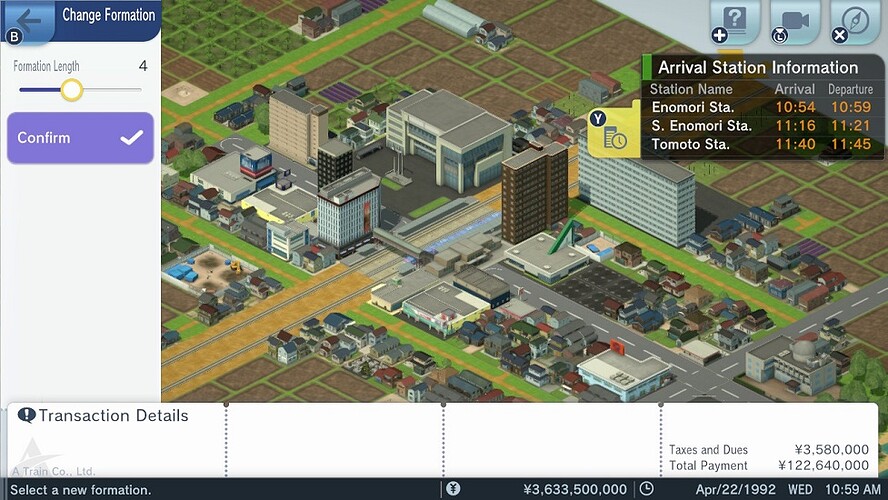Before we begin the next entry in the Let’s Play All Aboard Tourism series, it wouldn’t be right to have a thread called ‘Let’s take the A-Train’ without sneaking in some ‘Take the A-Train’ somewhere along the line:
Please have your tickets ready for inspection by the conductor and prepare to board today’s train, as our railroading adventure in All Aboard Tourism continues!
Let’s Play All Aboard Tourism - We built this city on transit fueled growth…
Click to reveal...
Swiftly gathering steam from where we left off yesterday, when we commenced active train services between Hasuoka and Nagashirojo and established our first tourist route. Today will be all about city development, expanding and modifying our rolling stock to cope with increases in ridership, and investigating the possibility of establishing some subsidiaries near Nagashirojo Station.
First, we will cover the important topic of city development. Whilst in A-Train: All Aboard Tourism we can construct our own subsidiary businesses, ranging from residential apartments all the way through to amusement parks, an important element of the game is fueling AI-controlled development. This is primarily achieved by transporting passengers to stations, with the resulting foot traffic subsequently driving growth in the surrounding area.
Before we commenced shuttling passengers, both local residents and tourists, to Nagashirojo Station we can see that the development status of the surrounding area was sitting at the “None at All” rating. Thus, whilst the odd new or redeveloped building might appear over the span of a few years, we could not expect the surrounding area to achieve much growth.
When we skip forwards a week from April 7th to April 15th we notice that the development status has begun to change and subsequently resides at “Proceeding Well”. An influx of over 3000 daily users visiting the local area, primarily tourists attracted to Nagashirojo Castle, has begun to drive growth in the local area and encourage urban development. As more foot traffic begins to flow into Nagashirojo Station due to our active train services from Hasuoka so will the development status continue to change to reflect the growing impetus for the local area to grow.
The Notices section of the user interface allows us to keep an eye on urban development whilst playing, as we receive news that development is advancing quickly around the Enomori and Nagashirojo stations. Thanks to heavy foot traffic around Enomori Station the town has recently had a clinic be constructed, with other building projects also currently underway.
We can also notice that an increasing number of tourist from Hasuoka are beginning to utilise our train services. As we soon reach a total of 10,000 annual tourist visits just 15 days into our role as CEO of the company and expansion of the previous transportation infrastructure. Meanwhile, we continue to work our way towards turning our current predicted gross loss of 115,340,000 Yen into a gross profit by the end of our first financial year, through the growth of our net sales.
Taking a look at our current roster of active trains we can see that our trains are beginning to reach full capacity during the day. The influx of tourists from Hasuoka to visit Nagashirojo Castle only continues to grow and there are occasions when local passengers are having to wait for another train to travel to their next stop. Thus, it might be time to consider expanding the capacity of our trains either by adding additional cars to their consist or replacing the current rolling stock with a new type that boasts greater passenger capacity.
Today we are going to explore both options, since changing train formation is an advanced setting that is not initially available within the first tutorial. Therefore, we are going to purchase one Suburban 1 type EMU (Electric Multiple Unit) for the purposes of showing off how to seamlessly replace one train with another. Since doing this will allow us to copy over our existing operating schedule settings rather than having to spend a couple of minutes configuring everything.
When using the Withdraw option, replacing the Place option once a train has been placed, we are subsequently given two options. We can either confirm the withdrawal of the selected train from our railway network, or we can use the Replace option to switch the selected train with one that is current waiting in storage. Thus, we will choose to replace one of our Suburban 2 type trains with our recently purchased Suburban 1 type train. Once this has been done, as shown in the picture above, and we confirm our decision we will be asked whether we want to copy over the existing operating schedule, to which we will answer yes.
When the Change Formation advanced setting is enabled we gain access to the ability to, as the name implies, modify the consist of our trains. Typically, this can only happen when a train has come to a halt and thus modifying existing trains is often done when they are stopped at a station. Upon choosing the train we wish to modify and selecting Change Formation we are given a slider to change the number of passenger cars being used. However, this option isn’t without cost as increasing the capacity of our train will require buying a new passenger car for it, a total cost of 122,640,000 Yen.
Consequently, we quickly reach a total of 20,000 annual tourist visits by April 25. Fueled by the expansion of our existing trains and the introduction of the new Suburban 1 type EMU to our Hasuoka-Nagashirojo service. With the Suburban 1 type EMU having a greater passenger capacity than our Suburban 2 type EMUs.
Nearing the end of the month, our net sales continue to grow throughout our first month as CEO as our trains continue to transport an ever increasing number of passengers across our transit network. However, the expansion of our existing trains and the introduction of the new Suburban 1 type EMU to our Hasuoka-Nagashirojo service has further increased our railroad expenses. Meaning we currently are forecast to have a Net Loss of 1,218, 650 Yen once corporate taxes and other factors are included.
Plenty of time still remaining in the financial year to convert those numbers into a net profit. However, we will have to be strategic with our spending if we want to achieve that goal. Since parameters such as shareholder confidence are active, thanks to playing on normal difficulty, we will want to end the financial year with a good net profit. To retain the trust of the company’s private shareholders we will want to be able to pay out at least a 3% dividend when the time comes next year, in 1993.
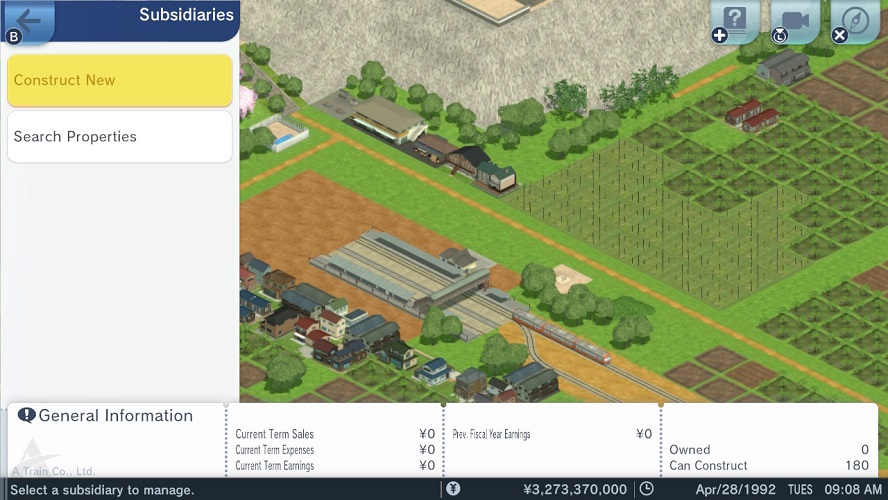
Next we will investigate establishing subsidiaries around Nagashirojo Station to further benefit from the number of people traveling to and from the local area. Before we do anything though lets revisit the Government Policies menu and acquire the subsidy for constructing three or more commercial type buildings in the Nagashiro district that we mentioned during part two of the Let’s Play. Getting a 95% subsidy to land acquisition costs is a bargain too good to pass up, in my opinion. Then we will proceed to constructing some new, company owned, buildings in Nagashirojo.
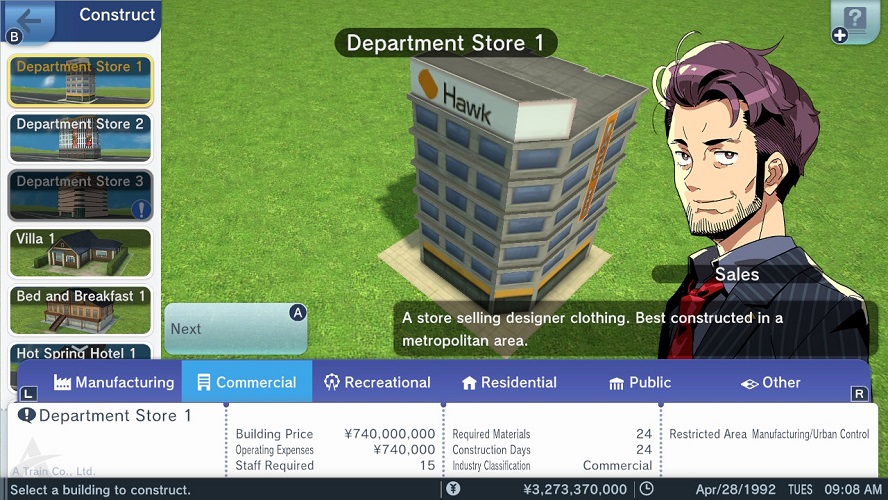
Within the construct menu we can select from a variety of building types, broken down into six main categories. Our subsidy calls for us to build three buildings of the commercial type, from which we can choose from a wide array of options that have different construction costs, operation expenses, construction material requirements, and construction time frames. We will start out simple and begin by building Department Store 1, a basic entry level department store.
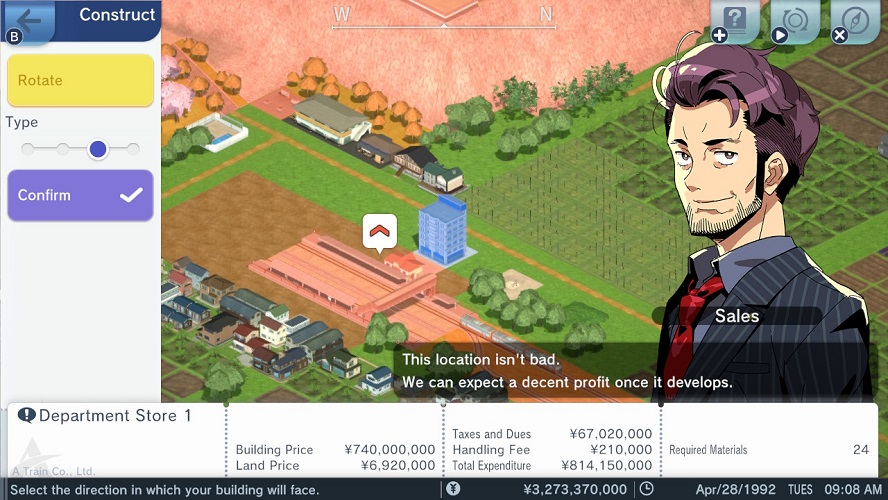
Depending on their location, subsidiaries can synergise or conflict with other buildings in the surrounding area. We can see from the above picture that constructing our department store next to our station building will be a fruitful symbiotic relationship. Our Sales advisor also gives us his opinion on our chosen location and performance forecast. Due to the strong growth forecast for the region I suspect we should not encounter many issues with the local area developing further. Especially once we finish our strategic vision for the area, with the construction of further subsidiaries.
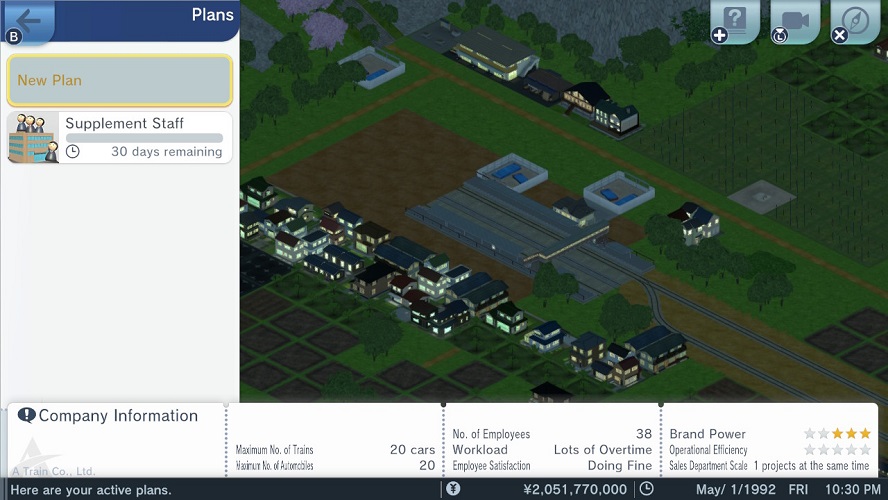
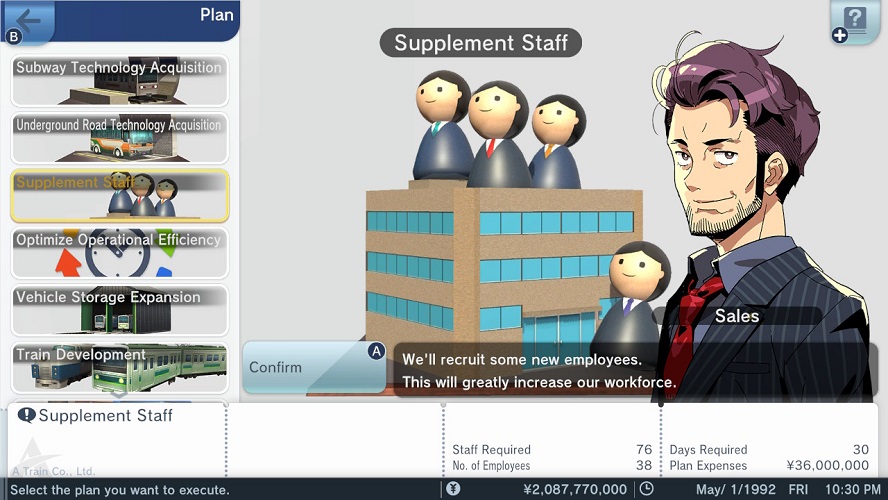
Before we do that though it is time we expanded our number of employees by instituting the Supplement Staff plan. As we can see in the above pictures we currently have 38 employees and ideally should be employing 76 employees to handle the workload of operating all our business concerns. The recruitment process will cost us 36,000,000 Yen and take 30 days to complete.
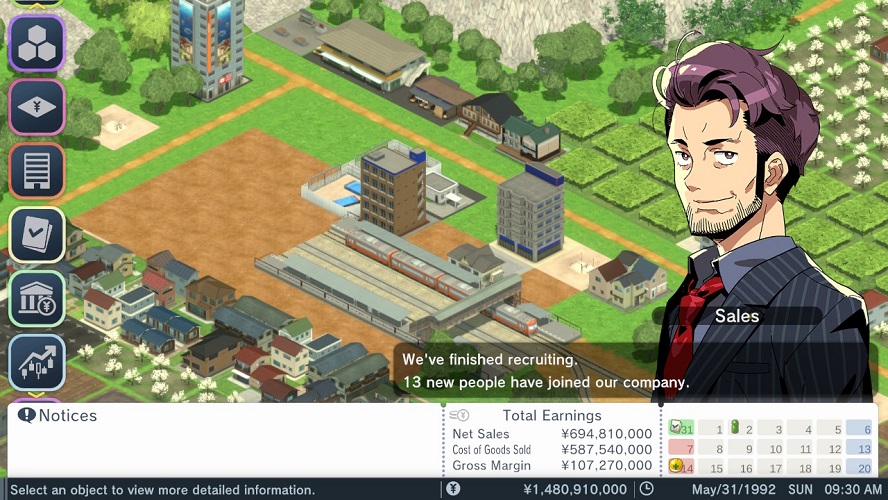
Subsequently, on May 31st we receive a message from our Sales advisor that we have completed the hiring of 13 new employees to our company. Lessening the workload experienced by our existing 38 company staff. This expansion in company staff does obviously mean that we will be adding to our company’s expenses due to the wages and other associated costs of these new recruits.

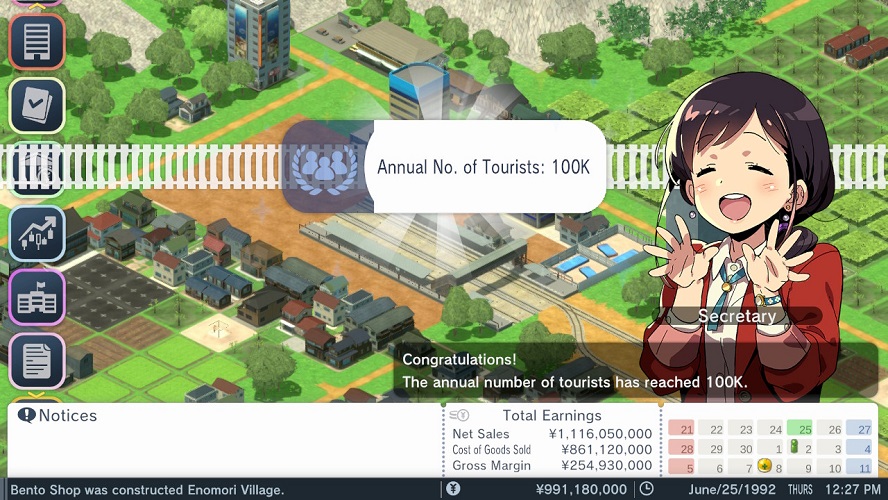
As we continue constructing subsidiaries around Nagashirojo Station we receive news that on June 14th we have reached the halfway mark of our 20,000 population goal for the scenario. Then on June 25th we also reach the halfway mark of our goal for 200,000 annual tourist visits.

After beginning construction of three commercial buildings in the Nagashirojo district we receive payment of our subsidy from the local government. As well as a department store, our company has constructed a seafood restaurant and a low-rise commercial building. Due to the terms of the subsidy we had in place with the local government, 95% subsidy to land acquisition costs, we made sure to build all three of our commercial buildings on non-company owned land. This allows us to acquire some new land around our station for relatively cheap and preserve some of our existing company owned land for later non-subsidised development.
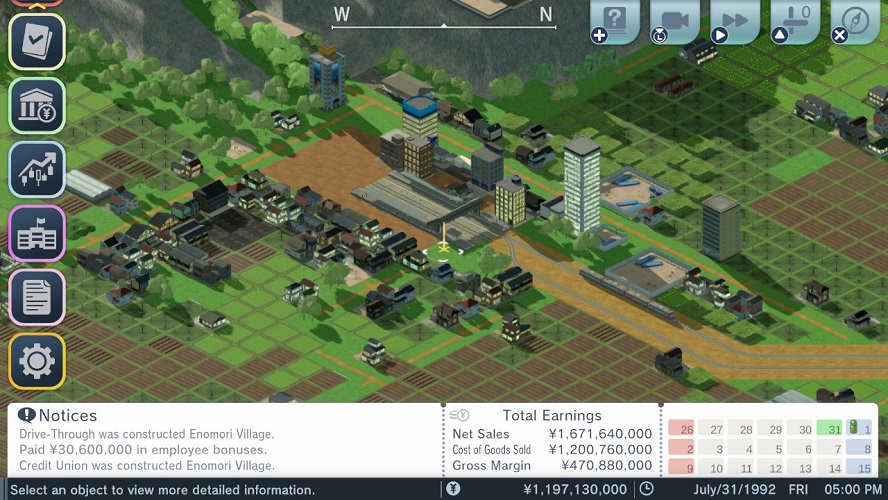
By July 31st we have constructed a total of five subsidiaries around Nagashirojo Station. In addition to our three commercial buildings we have constructed two residential apartment buildings. These company owned residential apartments synergise well with not only our station but also our commercial buildings. As well as providing a boost to local ridership on our Hasuoka-Nagashirojo service, these two residential apartments boost the number of people using the services of our three commercial buildings.
Earning revenue from people because of where they both live and shop? What isn’t there to love about it as a business.
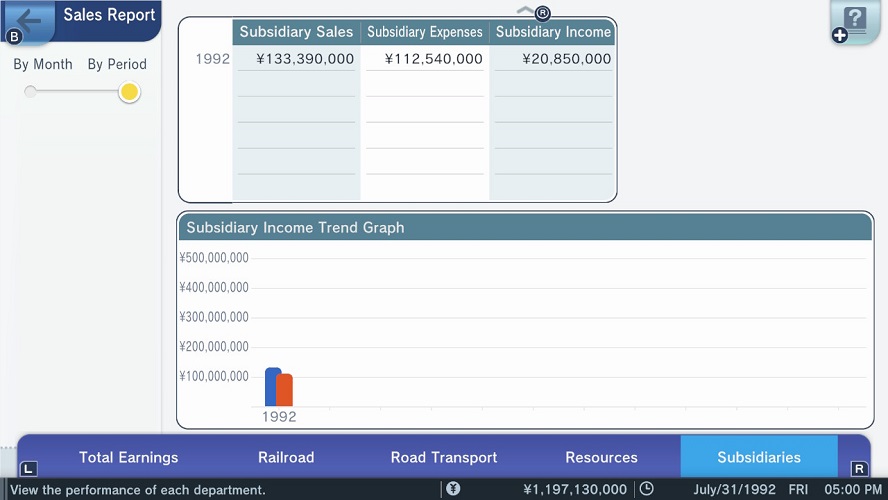
Which leads us into examining the sales report screen and seeing how well our subsidiaries are doing as a whole. As of July 31st, currently all our subsidiaries are earning us a daily profit and have so far amassed a total combined profit of 20,850,000 Yen. When extrapolated out over a year, especially as urban development around Nagashirojo continues flourish, we will be looking at a rather healthy annual profit from our current subsidiaries.
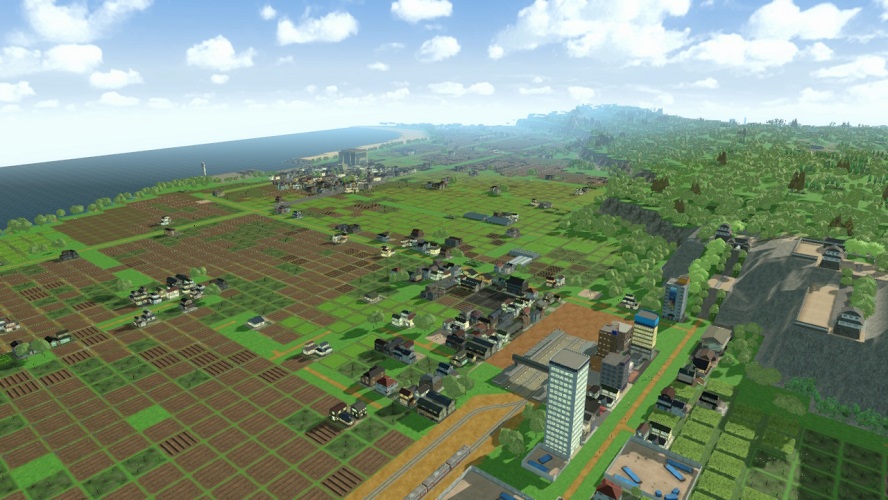
And on that note, that concludes part four of Let’s Play All Aboard Tourism. Do join me when we continue to expand our business operations and edge closer towards our goals for completing the scenario. Next on the agenda? Possibly learning all about using bank loans to fuel further strategic expansion, as we eye off connecting the southern portion of the map and the establishment of a tourist route with the mid-sized city of Komita. Until the next time we met, I hope you have a safe journey aboard the A-Train!
